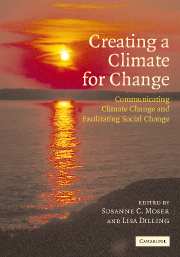Book contents
- Frontmatter
- Contents
- Preface
- Foreword
- List of contributors
- List of tables
- List of figures
- List of text boxes
- Introduction
- Part I Communicating climate change
- Part II Facilitating social change
- 15 Stuck in the slow lane of behavior change? A not-so-superhuman perspective on getting out of our cars
- 16 Consumption behavior and narratives about the good life
- 17 Educating for “intelligent environmental action” in an age of global warming
- 18 Education for global responsibility
- 19 Changing the world one household at a time: Portland's 30-day program to lose 5,000 pounds
- 20 Changing organizational ethics and practices toward climate and environment
- 21 Change in the marketplace: business leadership and communication
- 22 The market as messenger: sending the right signals
- 23 Making it easy: establishing energy efficiency and renewable energy as routine best practice
- 24 Forming networks, enabling leaders, financing action: the Cities for Climate Protection™ campaign
- 25 Ending the piecemeal approach: Santa Monica's comprehensive plan for sustainability
- 26 States leading the way on climate change action: the view from the Northeast
- 27 West Coast Governors' Global Warming Initiative: using regional partnerships to coordinate climate action
- 28 Building social movements
- 29 Climate litigation: shaping public policy and stimulating debate
- 30 The moral and political challenges of climate change
- Part III Creating a climate for change
- About the authors
- Index
- References
20 - Changing organizational ethics and practices toward climate and environment
Published online by Cambridge University Press: 20 August 2009
- Frontmatter
- Contents
- Preface
- Foreword
- List of contributors
- List of tables
- List of figures
- List of text boxes
- Introduction
- Part I Communicating climate change
- Part II Facilitating social change
- 15 Stuck in the slow lane of behavior change? A not-so-superhuman perspective on getting out of our cars
- 16 Consumption behavior and narratives about the good life
- 17 Educating for “intelligent environmental action” in an age of global warming
- 18 Education for global responsibility
- 19 Changing the world one household at a time: Portland's 30-day program to lose 5,000 pounds
- 20 Changing organizational ethics and practices toward climate and environment
- 21 Change in the marketplace: business leadership and communication
- 22 The market as messenger: sending the right signals
- 23 Making it easy: establishing energy efficiency and renewable energy as routine best practice
- 24 Forming networks, enabling leaders, financing action: the Cities for Climate Protection™ campaign
- 25 Ending the piecemeal approach: Santa Monica's comprehensive plan for sustainability
- 26 States leading the way on climate change action: the view from the Northeast
- 27 West Coast Governors' Global Warming Initiative: using regional partnerships to coordinate climate action
- 28 Building social movements
- 29 Climate litigation: shaping public policy and stimulating debate
- 30 The moral and political challenges of climate change
- Part III Creating a climate for change
- About the authors
- Index
- References
Summary
Introduction
Business organizations play an increasingly important role in the world … Companies that win the public's confidence and trust are open, visible, engaging and create business value while delivering benefits to society and the environment.
William Ford, Chairman and CEO Ford Motor CompanyRapid technological changes, pressures created by globalization, competition, and increasing resource constraints make the management of organizational change a critical issue for organizations of all types. The scientific study of organizational change is an interdisciplinary endeavor and it has grown in step with the practical importance of change to organizations. Only a limited part of the science of change literature has, however, directly addressed how to change organizations in ways that would benefit the natural environment, in general, or the Earth's climate, in particular. Changing organizations to help address climate change is the focus of this chapter.
The force-field model of change
At any given time, any mature organization is in reality an epiphenomenon of a dynamic balance between its connections to the outside world and its internal components, processes, and functions. For any attempted organizational change, there will be internal and external forces that both support the change, and ones that push against it. For a change to occur, therefore, something must move an organization from its current state of balance to a desirable new and relatively sustainable dynamic balance. We will argue that achieving new and environmentally friendly (hereafter “green”) organization states requires broad and deep change in organizations' culture and systems.
- Type
- Chapter
- Information
- Creating a Climate for ChangeCommunicating Climate Change and Facilitating Social Change, pp. 303 - 318Publisher: Cambridge University PressPrint publication year: 2007



